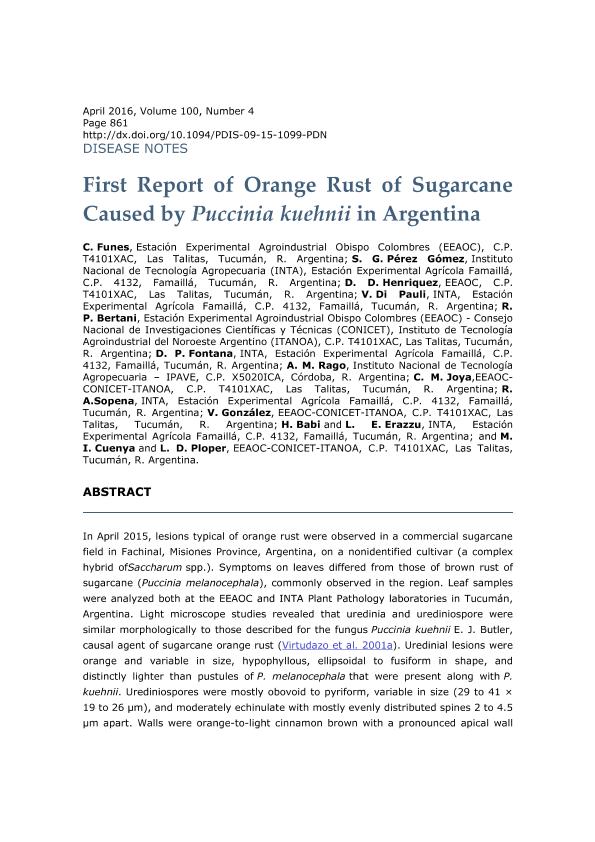Artículo
First report of orange rust of sugarcane caused by Puccinia Kuehnii in Argentina
Funes, C.; Pérez Gómez, S. G.; Henriquez, D. D.; Di Pauli, V.; Bertani, Romina Priscila ; Fontana, D. P.; Rago, Alejandro Mario; Joya, Constanza María
; Fontana, D. P.; Rago, Alejandro Mario; Joya, Constanza María ; Sopena, R. A.; González, V; Babi, H.; Erazzú, Luis Ernesto; Cuenya, María Inés
; Sopena, R. A.; González, V; Babi, H.; Erazzú, Luis Ernesto; Cuenya, María Inés ; Ploper, Leonardo Daniel
; Ploper, Leonardo Daniel
 ; Fontana, D. P.; Rago, Alejandro Mario; Joya, Constanza María
; Fontana, D. P.; Rago, Alejandro Mario; Joya, Constanza María ; Sopena, R. A.; González, V; Babi, H.; Erazzú, Luis Ernesto; Cuenya, María Inés
; Sopena, R. A.; González, V; Babi, H.; Erazzú, Luis Ernesto; Cuenya, María Inés ; Ploper, Leonardo Daniel
; Ploper, Leonardo Daniel
Fecha de publicación:
04/2016
Editorial:
American Phytopathological Society
Revista:
Plant Disease
ISSN:
0191-2917
Idioma:
Inglés
Tipo de recurso:
Artículo publicado
Clasificación temática:
Resumen
In April 2015, lesions typical of orange rust were observed in a commercial sugarcane field in Fachinal, Misiones Province, Argentina, on a nonidentified cultivar (a complex hybrid of Saccharum spp.). Symptoms on leaves differed from those of brown rust of sugarcane (Puccinia melanocephala), commonly observed in the region. Leaf samples were analyzed both at the EEAOC and INTA Plant Pathology laboratories in Tucumán, Argentina. Light microscope studies revealed that uredinia and urediniospore were similar morphologically to those described for the fungus Puccinia kuehnii E. J. Butler, causal agent of sugarcane orange rust (Virtudazo et al. 2001a). Uredinial lesions were orange and variable in size, hypophyllous, ellipsoidal to fusiform in shape, and distinctly lighter than pustules of P. melanocephala that were present along with P. kuehnii. Urediniospores were mostly obovoid to pyriform, variable in size (29 to 41 × 19 to 26 μm), and moderately echinulate with mostly evenly distributed spines 2 to 4.5 μm apart. Walls were orange-to-light cinnamon brown with a pronounced apical wall thickening as much as 7 μm. Paraphyses, telia, and teliospores were not observed. Identification of the pathogen was confirmed by molecular studies. The internal transcribed spacer region (ITS1-5.8S-ITS2) of the rust infecting a nonidentified sugarcane cultivar (GenBank Accession No. KT261382) was sequenced. The sequence was identical to sequences of P. kuehnii and distinct from known sequences of P. melanocephala (Virtudazo et al. 2001b). Orange rust, initially reported in the Asia-Pacific region, has caused important losses in Australia in 2000. In the Western Hemisphere, it was first reported in Florida in 2007 (Comstock et al. 2008). Since being reported in Brazil in 2009 (Barbasso et al. 2010), annual surveys have been conducted in all three sugarcane production regions of Argentina: Northern (Salta and Jujuy provinces); Northeast (Santa Fe and Misiones provinces); and Tucumán Province. At present, the only focus of orange rust infection detected is the one in Misiones Province, 1,200 km from Tucumán, the main sugarcane-growing region of the country. To our knowledge, this is the first report of P. kuehnii infecting sugarcane in Argentina. The possible economic impact of orange rust on sugarcane production in the country is still unknown, but considering its destructive potential, the disease may pose a serious threat to sugarcane production if environmental conditions favor its establishment during the early growth stages of the crop.
Palabras clave:
Puccinia Kuehnii
,
Orange Rust
,
Sugarcane
,
Detection
Archivos asociados
Licencia
Identificadores
Colecciones
Articulos(ITA-NOA)
Articulos de INST. DE TECNOLOG. AGROINDUST. DEL NOROESTE ARGENTINO
Articulos de INST. DE TECNOLOG. AGROINDUST. DEL NOROESTE ARGENTINO
Citación
Funes, C.; Pérez Gómez, S. G.; Henriquez, D. D.; Di Pauli, V.; Bertani, Romina Priscila; et al.; First report of orange rust of sugarcane caused by Puccinia Kuehnii in Argentina; American Phytopathological Society; Plant Disease; 100; 4; 4-2016; 861-861
Compartir
Altmétricas



